duet
Walckiers - Fantaisie pour la Flûte - Fl & Pf
 Fantaisie pour la Flûte, Op.65, by Eugène Walckiers
Fantaisie pour la Flûte, Op.65, by Eugène Walckiers
Gassett Collection - Facsimile Edition by C.A.Vater/Noteworthy Sheet Music, with a Foreword by Peter H. Bloom
Flute Part and Piano Score, PDF $19.50
A student of Jean-Louis Tulou, Eugène Walckiers (1793-1866) was a flutist and an exceptionally talented composer. His Fantaisie pour la Flûte Sur la Ronde du Postillon de Lonjumeau is a delightfully engaging and challenging work based on emblematic material from the comic opera by the French composer Adolphe Adam (1803-1856). The famous Ronde du postillon appears at the end of Act I of Le Postillon de Lonjumeau (The Coachman of Lonjumeau), which premiered in Paris in 1836.
For additional information about the Gassett Collection, please see see our article An Introduction to the Gassett Collection.
Piano score, 19 pages; Flute part, 8 pages; Total, 32 pages.
PreviewWeber - Andante e Rondo Ongarese - Alto Saxophone (and Piano)
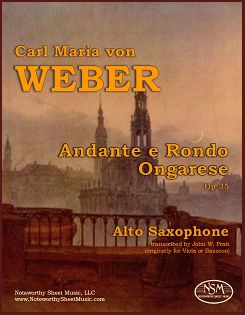 Andante e Rondo Ongarese, Op.35, by Carl Maria von Weber
Andante e Rondo Ongarese, Op.35, by Carl Maria von Weber
Transcribed for Alto Saxophone (and Piano) by John W. Pratt
Alto Saxophone Part, PDF $6.99
In presenting our transcription of the Andante e Rondo Ongarese by Carl Maria von Weber for alto saxophone, we are keeping with a long-standing tradition of creating saxophone arrangements of 19th century recital pieces. This piece was first written in 1809 for viola, but was revised in 1813 for bassoon, in which form it became increasingly popular. NSM previously published our own version of Weber's Op.35 for clarinet, and after consultation with our saxophonist colleagues we decided to offer an alto saxophone version as well. In preparing his transcriptions of this fun, challenging piece, John Pratt worked from the public domain edition for piano and bassoon at imslp.org, where a free pdf download of the piano part is available. Our edition provides the transcribed solo part, which works perfectly with the pre-existing piano score.
Alto Saxophone part, 5 pages; Total, 8 pages.
Weber - Andante e Rondo Ongarese - Clarinet (and Piano)
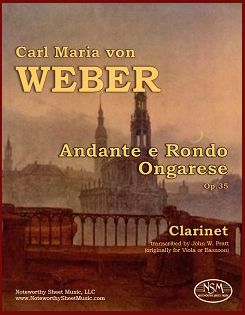 Andante e Rondo Ongarese, Op.35, by Carl Maria von Weber
Andante e Rondo Ongarese, Op.35, by Carl Maria von Weber
Transcribed for Clarinet (and Piano) by John W. Pratt
Bb Clarinet Part, PDF $6.99
Carl Maria von Weber (1786-1826) is widely credited with being a founder and leading composer of the Romantic school. He was prolific, making major and influential contributions to almost every kind of music, including 7 operas and 3 Singspiels, other vocal and choral music, orchestral and wind music, and piano music. Yet his chamber music consists of just 9 works (counting a set of 6 minor violin sonatas as one), and only the Grand Duo, the flute trio, and the clarinet quintet are substantial. The scarcity of Weber's chamber music makes a transcription of a concertante work, especially a fine one not often played like the Andante e Rondo Ongarese, particularly welcome. Weber’s Op.35 was first written in 1809 for viola (J79), but revised in 1813 for bassoon (J158) and apparently proved more popular in that form. Combining the viola's range and the bassoon's timbre points inexorably to the clarinet.
— excerpted from J.W.P.’s foreword to the edition
Clarinetists will find this work challenging and fun to play. We provide our clarinet transcription; a suitable piano part is readily available in the public domain as a free high quality pdf download of the score for bassoon and piano, which can be found at imslp.org: Piano Score
Bb Clarinet part, 5 pages; Total, 8 pages.
PreviewWeber - Grand Duo Concertant - Alto Flute
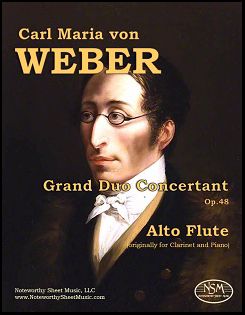 Grand Duo Concertant, Op.48, by Carl Maria von Weber
Grand Duo Concertant, Op.48, by Carl Maria von Weber
Transcribed for Alto Flute (and Piano) by John W. Pratt
Alto Flute Part, PDF $9.98
Carl Maria von Weber (1786-1826), an important forerunner of the Romantic school, was a prolific composer, yet wrote only three substantial chamber works. One is the Grand Duo Concertant for clarinet (or violin) and piano. Sounding a bit like Mozart on steroids, with robust harmonies and brilliant passagework, it has three movements - an exciting Allegro con fuoco, a beautiful Andante with a very rich, chordal piano accompaniment and passionate piano interlude, and a sparkling Rondo. We offer this excellent alto flute transcription of the clarinet part; the piano part is readily available in the public domain, as a free high quality pdf download of the score for clarinet and piano; here is a link to the listing on imslp.org: Piano Score
Alto Flute part, 10 pages; Total, 12 pages.
PreviewWeber - Grand Duo Concertant - Flute
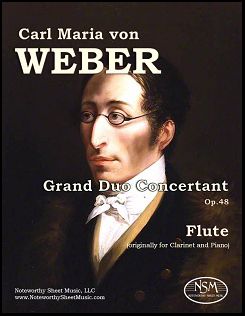 Grand Duo Concertant, Op.48, by Carl Maria von Weber
Grand Duo Concertant, Op.48, by Carl Maria von Weber
Transcribed for Flute and Piano by John. W. Pratt
Flute Part, PDF $9.98
Carl Maria von Weber (1786-1826), an important forerunner of the Romantic school, was a prolific composer, yet wrote only three substantial chamber works. One is the Grand Duo Concertant for clarinet (or violin) and piano. Sounding a bit like Mozart on steroids, with robust harmonies and brilliant passagework, it has three movements - an exciting Allegro con fuoco, a beautiful Andante with a very rich, chordal piano accompaniment and passionate piano interlude, and a sparkling Rondo. This flute transcription of the Weber clarinet part is an NSM favorite. The piano part is readily available in the public domain, as a free high quality pdf download of the score for clarinet and piano; here is a link to the listing on imslp.org: Piano Score
Flute part, 10 pages; Total, 12 pages.
PreviewWeber - Grande Polonaise, Op.21 - Two Flutes
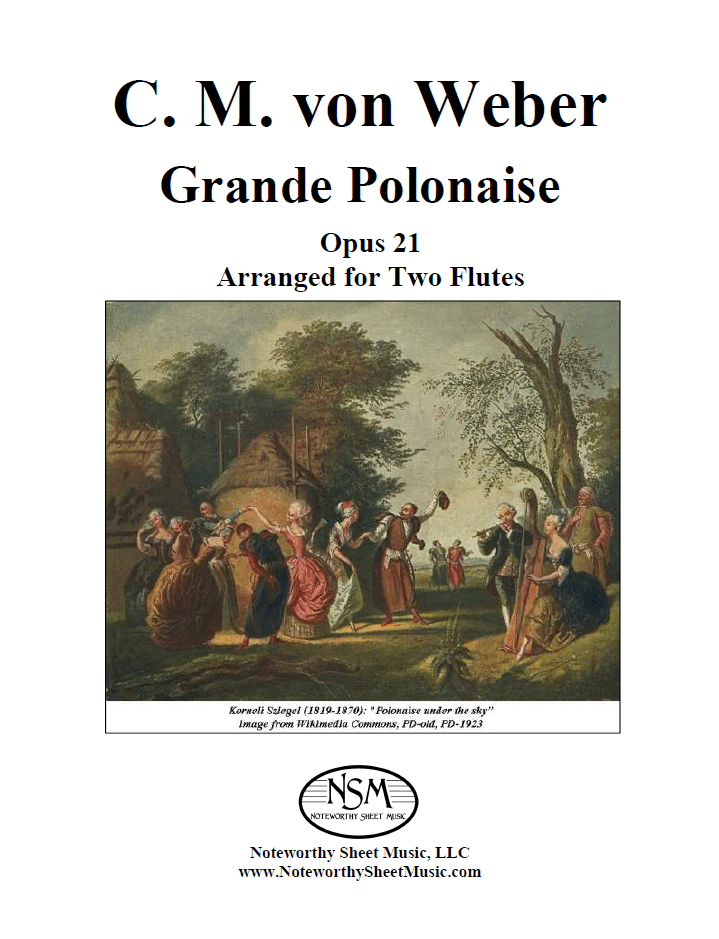 Grande Polonaise, Op.21, by Carl Maria von Weber
Grande Polonaise, Op.21, by Carl Maria von Weber
Anonymous Arrangement for Two Flutes
Gassett Collection - New Edition by C.A.Vater/Noteworthy Sheet Music
Flute 1 Part, Flute 2 Part, and Score, PDF $7.99
Carl Maria von Weber's Grande Polonaise, Op.21 was written originally for piano solo. The piece was composed in 1808 and first published in 1815. The Gassett Collection of 19th century flute music contains an edition of this piece arranged anonymously as a duet for two flutes, along with a flute duet version of Weber's Polacca Brillante in E major, Op.72, which we also offer. We re-notated the flute arrangement of the Grande Polonaise and offer this new edition, which includes a score at no extra charge, as well as the two flute parts.
For additional information about the Gassett Collection, please see see our article An Introduction to the Gassett Collection.
Flute 1 part, 4 pages; Flute 2 part, 4 pages; Fl1/Fl2 Score, 10 pages; Total, 24 pages.
PreviewWeber - Polacca Brillante, Op.72 - Two Flutes
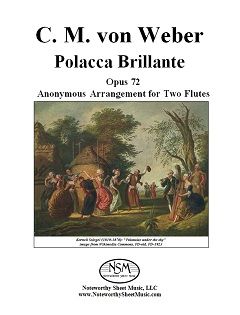 Polacca Brillante, Op.72, by Carl Maria von Weber
Polacca Brillante, Op.72, by Carl Maria von Weber
Anonymous Arrangement for Two Flutes
Gassett Collection - New Edition by C.A.Vater/Noteworthy Sheet Music
Flute 1 Part, Flute 2 Part, and Score, PDF $7.99
Carl Maria von Weber (1786-1826) was a German piano virtuoso and prolific composer who made major, influential contributions to many kinds of music and is widely credited with being a founder of the Romantic school. Weber's rousing Polacca Brillante in E major, Op.72 (alternatively known as L'Hilarité or Grande Polonaise brillante) was written originally for piano solo. It was composed and first published in 1819, and was later transcribed by Liszt for piano and orchestra.
We came across an anonymous arrangement of this piece, a duet for two flutes, among the print copies included in the Gassett Collection. The duet is great fun for flutists, so we created a renotated edition of the arrangement, with the goal of modernizing the format and correcting some likely inaccuracies. Our new edition includes a score at no extra charge as well as the two flute parts.
For additional information about the Gassett Collection, please see see our article An Introduction to the Gassett Collection.
Fl1/Fl2 Score, 8 pages; Flute 1 part, 4 pages; Flute 2 part, 4 pages; Total, 22 pages.
Preview